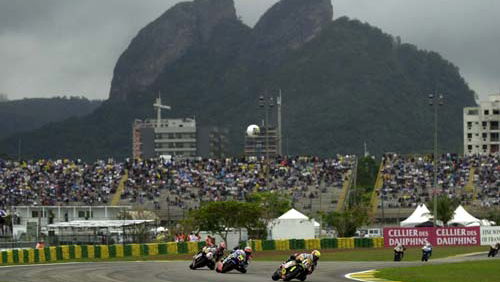Yamaha set-up report - Rio de Janeiro.
It was a thrilling two-part Brazilian race that concluded not only the 16 round 2001 MotoGP 500 World Championship, on November 3, but the era of the two-stroke only GP500s as well - with the MotoGP premier class opening up to 990cc four-strokes for 2002.

It was a thrilling two-part Brazilian race that concluded not only the 16 round 2001 MotoGP 500 World Championship, on November 3, but the era of the two-stroke only GP500s as well - with the MotoGP premier class opening up to 990cc four-strokes for 2002.
And the man who looked set to win this historic event was Carlos Checa; that was until he met a lapped Antoney West on the final turn, who unintentionally disrupted the Spaniard's rhythm and allowed the trailing Valentino Rossi to close the gap - the newly crowned world champion claiming the win on aggregate time by a mere 0.143 seconds.
Although it was resurfaced only three years ago the Rio de Janeiro circuit doesn't have a reputation for offering the traction one would hope for while racing a 200-plus horsepower machine.
In fact a combination of many bumps, low grip levels and camberless medium to high-speed corners make this a challenging circuit to stay on, let alone race on. Since there's only one extremely hard braking corner, most of the technical team's attention will be focused on manoeuvrability, but more importantly drive. Past experience has shown this is the key area for success.
Initially efforts were aimed at keeping the bike manageable on the medium to high-speed changes in direction by firming up the rear shock to prevent it from squatting under power. Working within the range of a higher rate rear spring the goal was achieved, but with a less than ideal side effect - the agility of the bike wasn't compromised, but the stability was.
The YZR500 became easily agitated, making it difficult for the riders to keep a flowing rhythm through the fast and crucial points on the track. The firmer spring also worked the rear tyre harder - causing the bike's feel to become unpredictable and unforgiving.
Yet agility is still a key concern; now achieved by preventing the rear from squatting under power with a softer spring rate, but with more preload to hold the shock high in its stroke.
Combined with less rebound damping - to allow the shock to return to its static length before the next series of bumps - feel has been improved and, therefore, control under power without sacrificing the positive handling traits initially sought after. Checa proved this last year with his impressive end of season performance on the YZR500, and therefore a similar approached will be followed in 2002 with the YZR-M1.
The continued efforts in improving the M1's rear shock linkage ratio, which is initially plusher than the ratio suitable on the more aggressively powered two-strokes, will only aid the Yamaha four-stroke further. Combined with the further development of the Deltabox chassis' geometry, tested in Estoril - which focuses on the Centre of Gravity, drive pivot shaft and general suspension balance - win number two for the M1 could be only a few laps away.
Again the front-end will follow the same basic theme to ensure an overall neutral balance, and with minimal hard braking it will allow more effort to be directed towards improving feedback from this area too.
As Rio is an acceleration circuit the power characteristics will be concentrated towards the midrange and top-end, while offering a good consistent delivery rather than a progressive power curve. The latter can make it difficult to drive off the side of the tyre effectively without the rear breaking traction as the revs rise rapidly.
This is where the four-strokes will have a huge advantage, and with temperatures usually hovering in the 30s, their power will suffer to a lesser extent than the more heat sensitive two-strokes.


